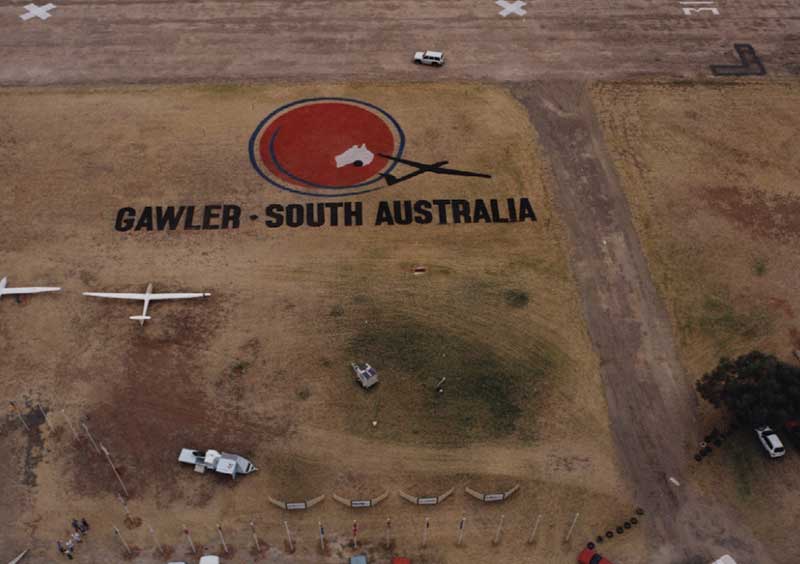
In the late 1990s, Australia submitted a bid to host the 2001 World Gliding Championships at Gawler in South Australia. The standards format was Open Class, 15m Class and Standard Class. We had excellent support from South Australia Major Events, who provided $250K towards the championships. I was chair of the sports committee at the time, and joined the competition organising committee.
Roger Woods was the IGC delegate, and he and I took our bid to the IGC meeting in March 1997. Unfortunately, we had competition from South Africa, which had attracted a lot of sympathy for their return to world gliding with the end of Apartheid and was an excellent site for gliding. South Africa won the ballot by one vote.
At that IGC meeting, interest had been expressed in introducing a World Championships for Club Class, which was very strong in Europe where regular championships were held. The USA and Australia had been running Sports Class nationals, which was similar but with a much broader mix of gliders permitted. This change would open up World Championships to many more pilots due to the availability of older design gliders.
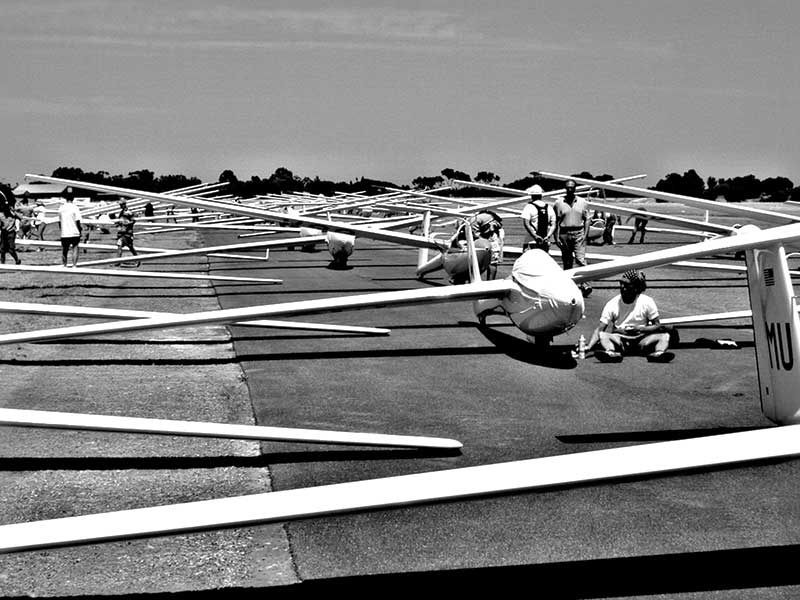
Gliders on the grid at the Club Class World Championships.
Seizing the Opportunity
Roger and I saw an opportunity to rescue our bid and developed a plan to encourage support for a Club Class World Championships, and to nominate Gawler as the venue.
Roger reported that the process for obtaining the Club Class World Championships for Australia depended on the IGC first agreeing that there should be such a World Championships, then altering the Sporting Code to allow the event to become an FAI sanctioned competition and finally, winning the bid for the first such event for Australia. The rules for the contest would have to be agreed by an IGC approved rules subcommittee.
The whole process was unlikely to be resolved until the next IGC meeting in March 1998, although it was evident that there had been considerable interest and enthusiasm for the concept at the 1997 IGC meeting.
Roger developed a series of motions to put to the 1998 IGC meeting to propose a Club Class Worlds at Gawler. As the meeting approached, Roger developed a terminal illness and eventually was unable to attend the meeting. He was, however, ‘holding on’ as the meeting approached to hear if his proposal had been accepted. I attended the meeting as the Australian delegate to put forward the Australian motions.
The motions to create the Club Class World Championships were successful and I immediately tabled a bid for the first championships to be held at Gawler in January 2001. This motion was also accepted and the Championships was awarded to Gawler. I immediately contacted the Woods family to pass on the great news to Roger.
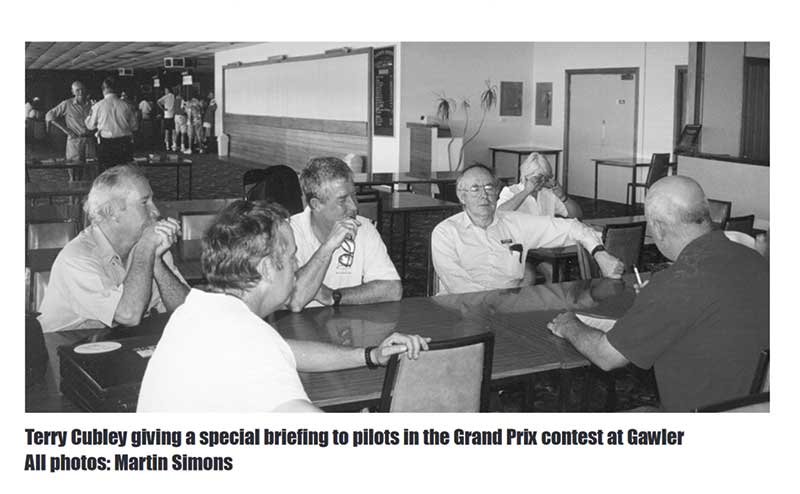
A New Type of Event
There was general discussion at both the 1997 and 1998 IGC meeting about trying to make gliding more interesting for the public but the conversation was not progressing.
The IGC accepted that our normal competition system was not attractive to the general public and was confusing in many ways. Our tasks took too long and it was unclear what was happening. Gliders took off and then disappeared. Some hours later, the gliders reappeared. The finish could be interesting but it was unclear who had won – was it the first one back, or someone who came in later? Some hours later, a list of the scores was put up and the winner announced, but by then, any spectators had gone home.
I reviewed a few other sports as a comparison to see why some were more popular, and the Motor Grand Prix offered some opportunity. The competitors shared a common start and competed over a set track to score for places, and the competitions were run as a series of heats. My initial proposal was quite basic, but good for a trial. A common start was important – that way you could watch the start and see the gliders leave. A set task did mean that you needed gliders of similar performance. We also needed to keep a finish line because that was exciting.
Scoring needed to be simple, so place scoring was a good call. It also meant that pilots couldn’t simply follow the crowd, because every place was worth points. Going with the gaggle in our normal races results in pilots being happy to go around and not make mistakes. But if you were rewarded for getting home before the opposition, it meant that you were encouraged to take ‘sporting’ risks to get back first. That was true racing, and could change the culture of glider racing.
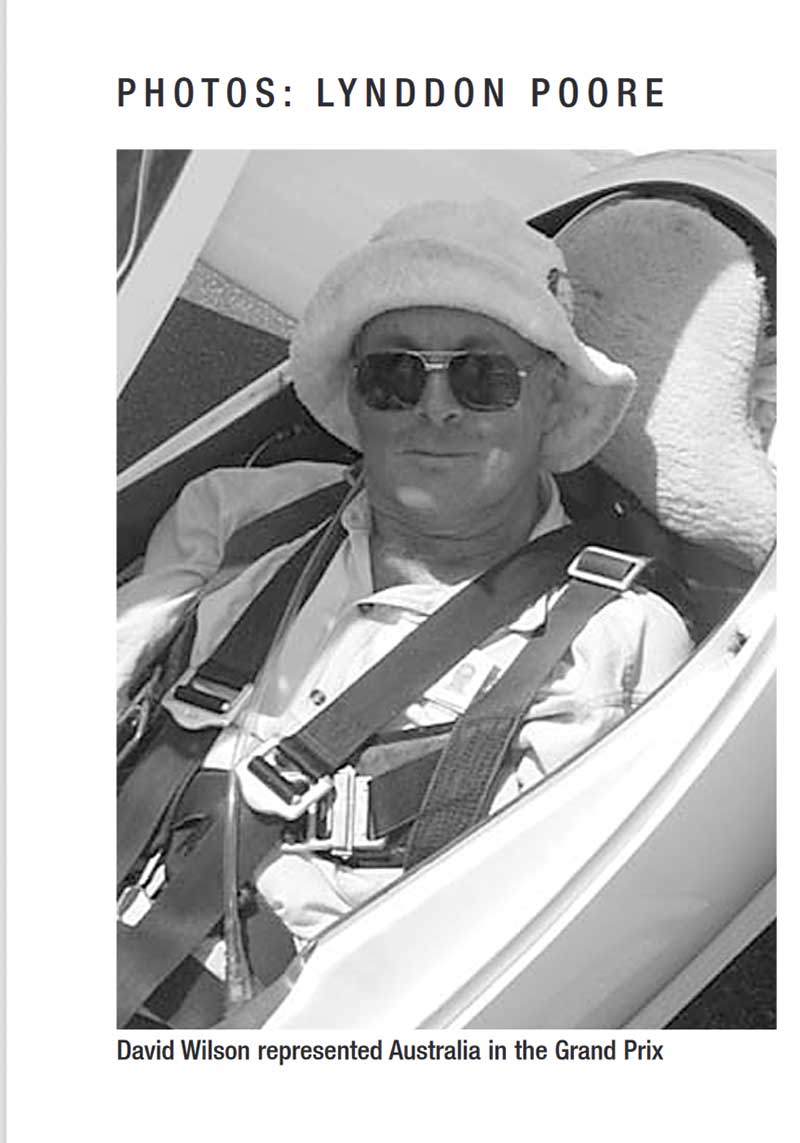
Grand Prix Concept
In considering this, I developed a formal proposal based on the Motor Grand Prix concept, which was later to become the Sailplane Grand Prix. The concept was short tasks, a racehorse start with everyone starting at the same time, first to finish wins, and a place scoring system, with 2 points for every competitor you beat. This would be easier to understand than the traditional 1,000 point system used in gliding. I even proposed that it would be run as a series of events around the world, shipping gliders from one event to the other.
I developed some simple rules that included short fixed tasks, a start circle and a finish line at the edge of the airfield – first one home, wins. It had to be interesting to the competitors and test their skills. It offered opportunities for tactical risk taking in order to reap a significant benefit, without punishing you too much for an error.
I tabled this proposal at the GFA Executive meeting and then presented a short overview at the following IGC meeting. There was some interest but not really a sudden acceptance.
In looking at the economics of the Club Class Worlds, it looked as though we would be lucky to get 35 to 40 gliders. I tried to get support from IGC for two separate groups within Club Class, but this idea was not supported. At the 1999 IGC meeting, I put forward the option of running the Grand Prix as a trial event alongside the Club Class pre-Worlds in January 2000, and alongside the World Comps in January 2001. This plan was accepted, and so the Sailplane Grand Prix was launched.
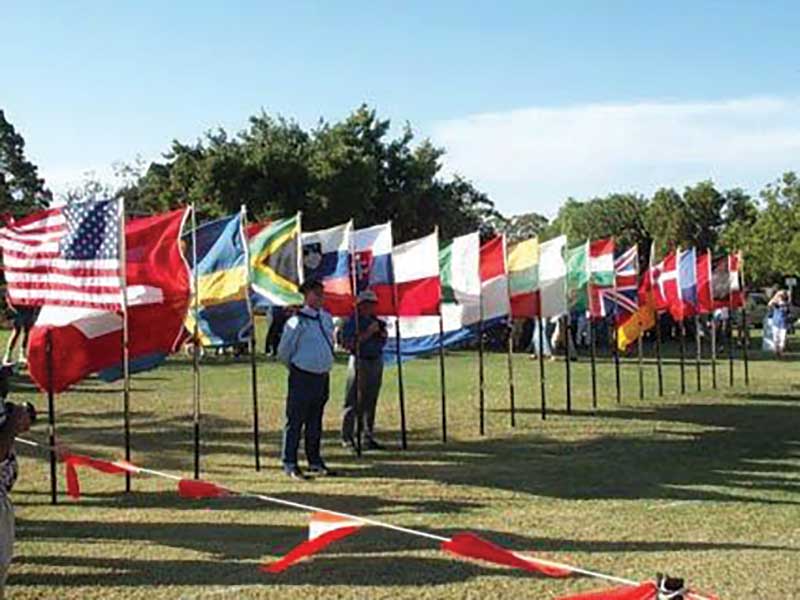
The opening ceremony.
SGP2000 at Barossaglide
The International Grand Prix in 2000 was part of Barossaglide, an event that included the Australian National Championships. It was a great success. There were only five entries, but the pilots had a great time with a demanding competition and lots of fun. Pilots were Peter Trotter, Arnie Hartley, Paul Matthews, Dave Wilson, Peter Buskens.
Despite the low number of participants, it exposed the concept to a number of international and Australian pilots who were attending Barossaglide.
We ran the event with a mix of Standard and 15m gliders, but with a restricted wingloading to reduce the impact of a performance advantage. It is interesting to note that the modern Sailplane Grand Prix has included this as an option to enable a broader mix of gliders to compete successfully. Standard Class gliders (Discus, LS8, ASW24) were allowed up to 45kg/m2, with 15m Class (ASW20, LS6, Ventus) limited to 43kg/m2.
There was a mix of one-on-one racing, independent racing and close finishes of a few seconds out to 20 minutes. All pilots enthusiastically endorsed the event, and the pilots in the Club Class competition watched eagerly.
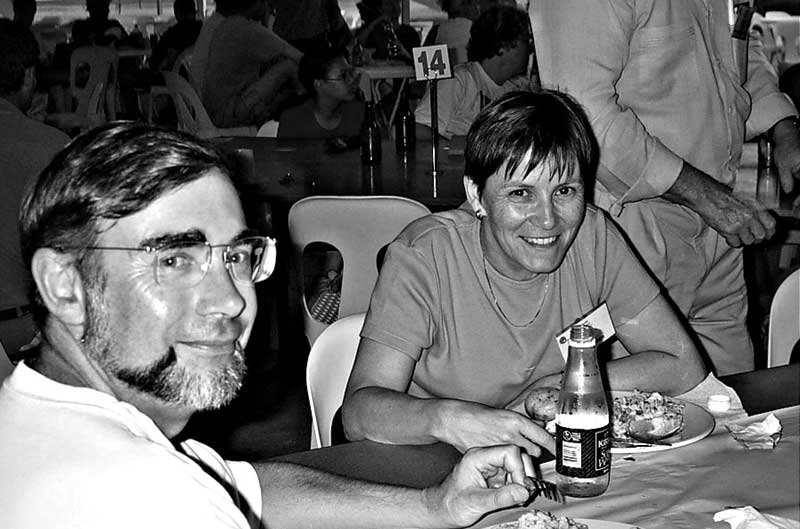
The scorers Tim and Joy Shirley.
Eight Competition Days
The weather was rather difficult, with weak and low climbs. We still managed eight competition days, but speeds and distances were not as expected – all fairly typical for a major competition.
The Grand Prix tasks were typically 200-350km with speeds around 100kph, although Peter Trotter won day four at 128kph.
Club Class tasks were exclusively POST, or Pilot Option Speed Tasks. This was the precursor to the Assigned Area Task, and pilots were given a minimum task time, one or two compulsory turnpoints, and the pilot could then choose any other turnpoints to try and maximise the distance within that allocated time.
The Club Class was run in the Australian Sports Class format with a range of gliders from Ka6 Boomerang and Bergfalke, through to Cirrus, Hornet, Discus and even the Nimbus3DM. This variety creates a challenge for task setters in trying to make sure that all gliders have a chance of completing the task, and isn’t always successful.
For details of the competition flying I refer you to the Skysailor report in March 2000. This was the time when Australian Gliding combined with the HGFA magazine Skysailor, to create Australian Gliding Skysailor, which later became Soaring Australia. This was a more cost effective approach but not accepted by all GFA members and eventually reverted to separate magazines in 2011.
safa.asn.au/images/skysailor_archive/pdfs/2000/2000-03AG_Skysailor.pdf
(Note that this edition also reports on a very young Adam and Chris Woolley).
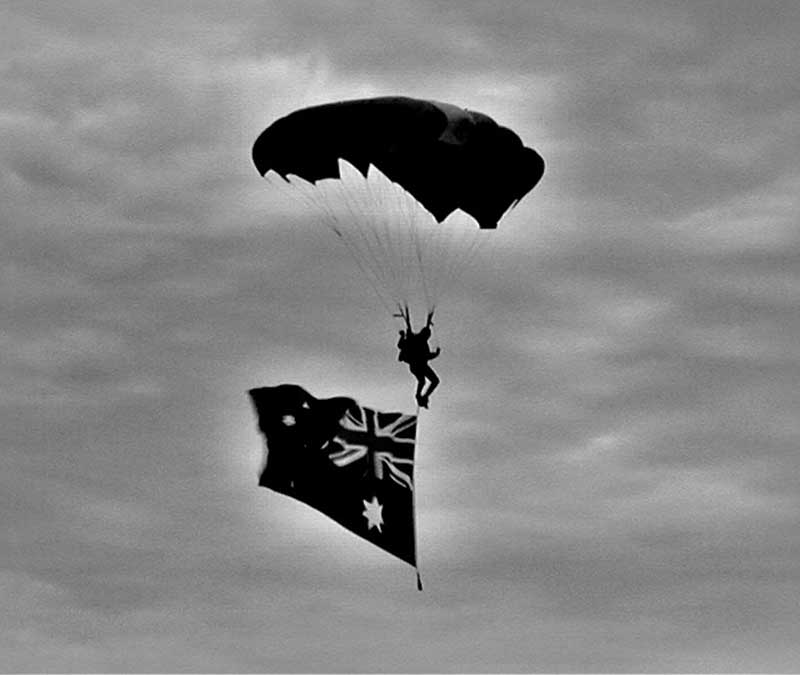 \
\
Bringing in the Australian flag by parachute.
World Club Class Championships and International SGP2001
The Adelaide Soaring Club members had a huge job in preparing for the World Championships. Problems with Harness Racing in SA meant that our plan to use the racecourse facilities could not proceed, so the club members decided to do a major renovation on the old clubhouse.
In addition, they set up a huge Santos-sponsored marquee adjoining the large air-conditioned hangar. What a great innovation that was! With seven days in a row exceeding 40 degrees, and one day at 46 degrees, this marquee was a major saviour of the event.
In the Club Class Worlds, 44 pilots competed from 22 countries. This is well short of the 30 to 35 countries currently taking part in the World Championships, and I suspect that a number of countries had not yet seen the value of Club Class as a legitimate World Championships. No entries came from New Zealand or France, among others.
Of course, transporting a glider half-way around the world for this event, in the same year they were sending gliders to South Africa for the other World Championships, was a very expensive exercise that some countries just could not afford. Many who came hired gliders from Australian clubs and private owners. Arnie Hartley spent many hours fixing the radios in these hired glders.
We only had six entries in the Grand Prix, but we were nonetheless able to fly the event, which provided an excellent demonstration to the world of what a great format the Grand Prix was.
Three international pilots competed – Jim Carpenter (Canada), Benno Beesten (Germany), Swantje Geyer (Germany) – alongside three Australians – David Wilson, Simon Brown and Mark ‘Bart’ Simpson.

Crossing the finish line.
Innovative Options
The event itself demonstrated the value of Club Class and the SGP, both of which have grown considerably in the past 20 years. Below are some innovative options the new competitions have introduced.
Start Circles
Australia had been using start circles instead of lines, to reduce conflict when starting and to reduce the amount of following. In Club Class, pilots were given a choice of three start points out of a total of nine. Somehow, all of the teams found that all of their pilots had a different set of start points on each day, aiming to reduce team flying.
It took two days for the teams to identify a convergence point where their pilots could meet up after the first glide out of the start.
SGP start was a circle. The pilots had to cross the boundary of the circle after the gate was opened. However, this idea has been surpassed by the use of a start line.
Task types
Club Class was flown with a mix of POST and the new Assigned Area Task, which had been developed in South Africa. That proved to be very popular and is certainly common now, in particular for Club Class.
Scoring
GPS was now common in gliding competitions, although the technology was not yet fully developed. The Cambridge, EW and the Borgelt Joey were relatively common devices in this championship.
Evaluating the GPS trace to score the event proved difficult for the computing power available at that time, but Tim Shirley developed a scoring script to enable this evaluation, basically a pre-cursor of See You. Tim sold quite a few scoring scripts after the comp to the International teams who were having similar problems back home.
These early GPS devices have some similar reliability problems to the old camera technology. One well known Australian pilot had a double logger failure during the comps, resulting in a score of zero for the day and making a comeback very difficult.
On a weak challenging day with a northerly wind, a gaggle of gliders climbing near to the field drifted into the airspace close by. GPS has no friends when it come to airspace, as it shows the scorer exactly where you were. Some 14 gliders earned zero for the day for this mistake.
Remote Finish
Gawler had earned a reputation for sea breezes, which made it difficult to get home from the task, so we introduced the option of a remote finish. A suitable field was found 25km north of Gawler and a finish here was counted as a finish for speed points, but with a small penalty of 50 points in the 2000 competition, increasing to 100 points in 2001. The benefit was that you could get a speed advantage rather than an outlanding, and avoid coming home into an increasing headwind in a Club Class glider, when your speed could reduce very easily. It was used by pilots on most days, and some pilots who chose not to use it, and then landed short of the finish line, wished that they had taken this option.
The competition
The weather was typically quite poor, with low heights and strong winds. Despite that, some pilots made some amazing flights. Many days in the first half were flown below 4,000ft, typically in blue thermals. There were some cu days of 6-7,000ft and a couple of days of 10-14,000ft, which is what the international pilots had come to experience. We even had one day where we set the task to the good conditions in the east, knowing that the pilots would have a great race but not be able to get home through the advancing front from the west. The front strengthened, wave formed and the pilots climbed to 15,000ft and flew home – a perfectly set task.
We lost the first three days to rain, flew the next seven days and then lost two days due to storms. The final day was a go and we ended up with eight competition days – not bad for a World Championships.
On the last competition day, one ‘well known Australian pilot’ finished the flight with a well planned and executed competition finish. A mini bus of Stewards drove down and then told the scorer, Joy Shirley, to make sure that the appropriate penalty was applied. Joy checked the rules and immediately applied the penalty of a warning for the first offence. This was certainly applauded by the congregation.
For an explanation of the details, see the March and April 2001 editions of SkySailor
bit.ly/3lWNAcZ and bit.ly/3DRtMy4
Outcomes
2000 and 2001 saw a very significant trial of new ways of racing and scoring gliding competitions.
Certainly Club Class had proven itself as an important and viable part of international glider racing. It is now typically the biggest class in World Championships, and is available to many more pilots from an access and affordability perspective.
Grand Prix Format
The Grand Prix proved itself as an exciting, high quality event. Roland Stuch (France) and Bob Henderson (NZ) were certainly impressed from the ground at Gawler, and over the next few years Roland led some major improvements in the competitions’ format and rules. The rules we used at Gawler were very basic, but he clarified these rules and penalties to ensure a consistent standard. He experimented with time-based scoring, like the type used for the Tour de France, but after a short time returned to place scoring.
Roland arranged the launch of the modern FAI SGP with an event at St Auban in France in 2005.
\youtube.com/watch?v=yAmybvge_Ec
Bob Henderson, John Roake and Peter Newport brought the SGP to the media through live tracking and video, which was run with the SGP at Omarama in New Zealand in 2006. bit.ly/3DM4jGb
Both of these sites have the benefit of being in mountain terrain, which is very attractive even to non-glider pilots.
The FAI International series is now in its 11th season and Australian pilots will have a chance to qualify by competing at Gawler in 2023. The concept has been been extended by Nick Gilbert with the F1 GP now called SkyRace – and this is flown in Club Class gliders. Again, access is improved significantly, and it is good fun.
SGP has come a long way in 20 years.































